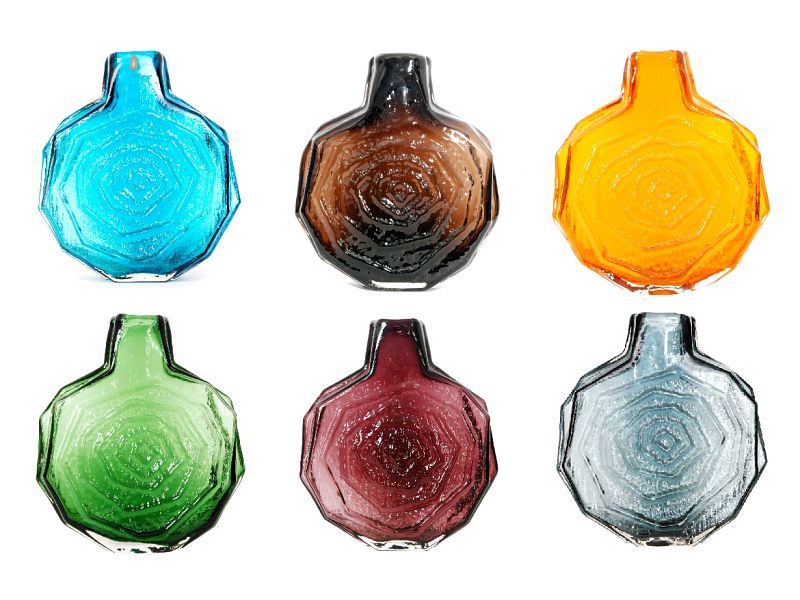Geoffrey Baxter - Whitefriars Glass
An Icon of Bristish Design
Geoffrey Baxter was one of the outstanding British glass designers of the post-war period. From 1954 until 1980 he worked for Britain's leading handmade glass manufacturer, Whitefriars Glass, designing a wide range of domestic glass, including tableware and ornamental glass. With radical shapes and bright psychedelic colours he helped put Whitefriars Glass on the post-war fashion map and became responsible for much of the company’s success during the 20th Century.
Three years before Queen Victoria ascended the throne, an entrepreneurial wine merchant, James Powell, purchased Whitefriars, a relatively obscure 17th-century London glassworks, named after the ancient monastery that had once occupied the site on the banks of the Thames. Over the following 100 years he and his descendants, as James Powell & Sons, transformed it into a decorative glass manufacturer of international standing. Whitefriars Glass became the Wedgwood of the British glass industry, a firm whose work was synonymous with the highest standards of design and creativity, and whose glass was sold by leading department stores throughout Britain, including Heals, John Lewis and Fortnum & Mason.
During the 1920s and 1930s Whitefriars embraced Modernism and became leaders of the Industrial Art Movement. After the Second World War their reputation remained high, and they were the only firm able to compete with the flood of imports from Scandinavia.
When Geoffrey Baxter joined Whitefriars in 1954, sleek Scandinavian Modern glass was all the rage. Although he was influenced by the clean-lined purity and elegance of the Scandinavian aesthetic, and was successful in producing designs which could compete with it on the British market, Baxter had a distinctive and individual style which was very much his own. The design climate in Britain had started to change boosted by the 1951 Festival of Britain as well as increasing consumer affluence and by producing a wide range of innovative new glassware in bright colours, Baxter was able to meet the demand for modern but affordable design.
When Baxter joined much of his initial output was cased and mould-blown pieces, with smooth, clean, organic lines characteristic of contemporary Scandinavian design. However, during the 1960s he began to develop his own highly distinctive style.
Nature provided much of the inspiration, but a new organic texture rather than organic shape became the focus. Baxter experimented with numerous methods of producing texture including lining the glass moulds with materials as diverse as tree bark, bricks, copper wire, and nail heads, all of which were to become highly effective and incredibly popular. The success of the textured range was further consolidated by the introduction of bold new colours such as Tangerine orange and Kingfisher blue.
Although examples of Whitefriars glass from all periods in the company’s history are hotly collected, pieces by Baxter are particularly desirable and values have risen a great deal over the past decade. With the value of his work it all comes down to colour! For example, as a rule-of-thumb Cinnamon is one of the least desirable colours while Tangerine is the most commonly found meaning prices generally are a little lower when compared to the rarer shades such as Pewter, Indigo and Willow. Pieces in the dramatic Kingfisher blue are always keenly contested while top prices are reserved for pieces in Aubergine, Meadow Green and Lilac. However for all collectors out there the holy grail of colours is Ruby Red! Rarely seen and incredibly sought after pieces in this colour can command as much as ten times their common equivalent.
The affection for his characteristic body of work is not only the textured surfaces and bold colours typical of the period but also the huge array of weird and wonderful shapes which look as fresh today as when they were first created. The Banjo, Totem, TV, Coffin, Nuts & Bolts and, above all, the amusingly asymmetrical and now iconic Drunken Bricklayer, are not only significantly less austere, more geometric, more urban, and far quirkier than their Scandinavian counterparts, they are also in these respects quintessentially British. However, all encapsulate not only Baxter’s individual style, but also much of the spirit of the vibrant, dynamic, pop-and-rock driven Swinging Sixties and early Seventies.
When buying Baxter, look for exceptionally large or rare pieces and shapes that are most likely to maintain or increase in value. Condition is critical as his pieces lack age, so check carefully for chips and cracks. It is also worth examining the definition to the surfaces as moulds tended to wear over time, producing a less crisp finish. Try to avoid any damage or accidental bubbles, especially if they interfere with a design. Prices vary a great deal and small cylindrical bark vases can be purchased from £20-30 upwards, especially in common tangerine, while a good banjo vase can fetch in the region of £1,000-2,000 depending on colour.
Ultimately it was the high labour costs involved in producing handmade glass, combined with the economic effects of the energy crisis and the recession of the late 1970s, which contributed to the downfall of Whitefriars Glass. Baxter, who had spent 26 years of his working life at the firm, was devastated by the closure of the glassworks and after the bulldozers had moved in he could never bear to return to the site.
Today his pieces sit easily in the modern aesthetic favoured by home owners and collectors alike. His timeless designs continue to remain a sound investment while bringing a splash of colour to a room and a smile to your face!
Posted on 14 August 2020
Be in the know
Sign up for auction email alerts so you never miss another sale at Fieldings!
Register now

